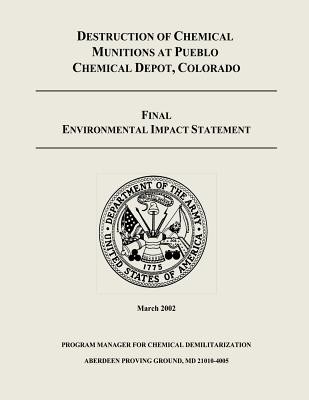
- We will send in 10–14 business days.
- Author: Department of the Army
- Publisher: CreateSpace Independent Publishing Platform
- Year: 2013
- Pages: 552
- ISBN-10: 1482733145
- ISBN-13: 9781482733143
- Format: 21.6 x 28 x 2.8 cm, softcover
- Language: English
- SAVE -10% with code: EXTRA
Destruction of Chemical Munitions at Pueblo Chemical Depot, Colorado - Final Environmental Impact Statement (e-book) (used book) | bookbook.eu
Reviews
Description
Public Law 99-145 and subsequent related legislation requires destruction of the U.S. stockpile of lethal unitary chemical agents and munitions. Furthermore, in 1993 an international treaty, the Chemical Weapons Convention (CWC), was signed by 65 nations, including the United States. The CWC, which set the deadline for completing destruction of chemical weapons as 10 years following ratification by the required number of nations, received the necessary ratifications on April 29,1997. Thus, the international deadline for destruction of chemical weapons as April 29, 2007. The Army Chemical Stockpile Disposal Program has prepared this Final Environmental Impact Statement (FEIS) to assess the potential health and environmental impacts of the construction, operation, and closure of a facility to destroy the chemical agent and munitions stored at Pueblo Chemical Depot (PCD), Colorado. Four alternatives are addressed in this FEIS for possible use in destruction of the PCD stockpile: (1) baseline incineration, which is currently in use by the Army at Deseret Chemical Depot (DCD), Utah and was used by the Johnston Atoll Chemical Agent Disposal System (JACADS) to destroy the entire stockpile on Johnston Atoll; (2) modified incineration, which is based on lessons learned at JACADS and DCD; (3) chemical neutralization followed by biotreatment, a developing technology that would be initially operated as a pilot test facility; and (4) chemical neutralization followed by super critical water oxidation, which is also under development and would be initially operated as a pilot test facility. The latter two alternatives are also being evaluated in a separate DEIS prepared by the Army Assembled Chemical Weapons Assessment Program (ACWA) as part of four chemical neutralization technologies being considered for pilot testing at PCD and three other chemical munitions storage locations. The data and information obtained from testing and full scale operation of the incineration technology, and available data and information from on-going studies of the neutralization technologies provided by ACWA are analyzed and compared to the extent possible in this FEIS.
EXTRA 10 % discount with code: EXTRA
The promotion ends in 19d.16:36:10
The discount code is valid when purchasing from 10 €. Discounts do not stack.
- Author: Department of the Army
- Publisher: CreateSpace Independent Publishing Platform
- Year: 2013
- Pages: 552
- ISBN-10: 1482733145
- ISBN-13: 9781482733143
- Format: 21.6 x 28 x 2.8 cm, softcover
- Language: English English
Public Law 99-145 and subsequent related legislation requires destruction of the U.S. stockpile of lethal unitary chemical agents and munitions. Furthermore, in 1993 an international treaty, the Chemical Weapons Convention (CWC), was signed by 65 nations, including the United States. The CWC, which set the deadline for completing destruction of chemical weapons as 10 years following ratification by the required number of nations, received the necessary ratifications on April 29,1997. Thus, the international deadline for destruction of chemical weapons as April 29, 2007. The Army Chemical Stockpile Disposal Program has prepared this Final Environmental Impact Statement (FEIS) to assess the potential health and environmental impacts of the construction, operation, and closure of a facility to destroy the chemical agent and munitions stored at Pueblo Chemical Depot (PCD), Colorado. Four alternatives are addressed in this FEIS for possible use in destruction of the PCD stockpile: (1) baseline incineration, which is currently in use by the Army at Deseret Chemical Depot (DCD), Utah and was used by the Johnston Atoll Chemical Agent Disposal System (JACADS) to destroy the entire stockpile on Johnston Atoll; (2) modified incineration, which is based on lessons learned at JACADS and DCD; (3) chemical neutralization followed by biotreatment, a developing technology that would be initially operated as a pilot test facility; and (4) chemical neutralization followed by super critical water oxidation, which is also under development and would be initially operated as a pilot test facility. The latter two alternatives are also being evaluated in a separate DEIS prepared by the Army Assembled Chemical Weapons Assessment Program (ACWA) as part of four chemical neutralization technologies being considered for pilot testing at PCD and three other chemical munitions storage locations. The data and information obtained from testing and full scale operation of the incineration technology, and available data and information from on-going studies of the neutralization technologies provided by ACWA are analyzed and compared to the extent possible in this FEIS.


Reviews